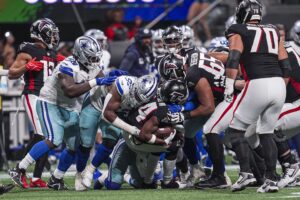The Kansas City Chiefs and Oakland Raiders are entering round one of a classic NFL rivalry. The two teams being mentioned in the same sentence bring up bitter memories for veterans on both sides. The mere mention of Arrowhead Stadium or the Black Hole can boil blood. Disappointment, anger, joy: the deepest of emotions are risen in players who have participated in the AFC West shaping matchups. Championship teams have been crafted and broken thanks to both teams. Even when either team is down, the dark stares and isolation reign in dim seasons. Although the scheme might be broken down to offer insight, there is no saying on the predictability. More than any other Sunday (or Thursday), the line of scrimmage will dictate the Chiefs and Raiders rivalry, no different than the 1970s. The Chiefs week seven scheme is not only about priming functionality, but ending the Raiders will to fight in all three phases of the game.
Kansas City Chiefs Week Seven Scheme Breakdown – Oakland Raider Week
Deceptive Practices
Although the Pittsburgh Steelers managed to beat the Chiefs, in doing so, the importance of the Chiefs establishing the run became overtly clear. The dictation of the line of scrimmage begins with Kareem Hunt getting volume carries on a short week. Playing on Thursday Night will be different than playing on Sunday – teams are more turnover prone, and mistakes will become clear.
Hunt’s emphasis is not so much about the Raiders, and more about the Chiefs being multi-dimensional. Without the ability to run or pass at will, the Raiders defense can bear down on specific play sequences and begin to form an outlook on how the Chiefs are scheming.
Applying the run game attack to the Raiders, after week one, a hole has opened in the middle of Ken Norton’s defense. The Raiders managed to hold the Tennessee Titans explosive run game to a mere 95 yards by physically imposing their will. Since that game, the Raiders defense has been an enigma, allowing an egregious 143 yards to the Baltimore Ravens. The short game (pass plays that are glorified runs) resulted in the Los Angeles Chargers Melvin Gordon tearing the defense apart.
Hence, those games provide a model to beat the Raiders. They have taken precautionary measures by signing linebacker NaVorro Bowman to play inside linebacker, and thus may return to the original two-dimensional defense design.
Norton’s aim is to present multiple looks out with his personnel for the purpose of aligning with any opponent. A desire to align to anyone may be a part of the Raiders problem; no true identity is no identity whatsoever. The clear micro identity, however, is Khalil Mack and Bruce Irvin destroying quarterbacks. The tenacious pass rush demands tackles Mitchell Schwartz and Eric Fisher play smart and agile, or risk letting Alex Smith spend the day on his back.
Mack is one of the most talented linebackers in the NFL, and thus has been featured rotating inward from the exterior position. Mario Edwards provides a rotational edge rusher. However, the problems and exposure begin here. Norton has invested so heavily into his blitz packages, when presented with the task of stopping run players, they do not own the proper packages to stop finesse running backs.
Over-pursuit and a lack of gap fit exhausts the Raiders defense, and allows offenses to create chunk plays. While the Raiders have done an excellent job at defending from explosive run plays, the potential for Hunt to break free several times exists. Mitch Morse’s return will pave the A and B gap runs for Hunt to pour on and control the ball.
Smith, who had a down week against the Steelers, is going to be facing a favorable Raiders secondary this week. The Raiders like to use their different corners in man-coverage, leaving safety Karl Joseph floating in a single-high spot. The point is for the corners to battle single routes, then let Joseph or Reggie Nelson jump the pass to create chaos.
Yet the Raiders identity has been more mixed. Again, the personnel do not fit the bill, leaving quarterbacks time to find receivers. Although the Raiders pass defense has not been tragic, and can surely recover with the presence of rookie corner Gareon Conley, the Chiefs scheme presents a direct attack point in Travis Kelce and Demetrius Harris. Tight ends and slot receivers have had a knack for getting open in the seams of the field when corners are glued to exterior or under routes.
Andy Reid loves to play coy in his presentations, bringing the onus to the defense to match their linebackers and safeties to the athletic Chiefs offense. With De’Anthony Thomas, Kelce, Harris, and Tyreek Hill, the Chiefs can layer their scheme and target the zone holes in the Raiders scheme. The Chiefs lack of traditional presentation works players in between the man coverages, and thus leaves a player open in the middle and flat.
Disavowing Opportunities
In games the Raiders won, they landed 22 and 21 first downs respectively. In games they have lost, the offense has yet to get over 15 first downs. Putting the matchup in the most simplistic terms, the Raiders offense is not winning the battle at the line of scrimmage.
Ideally, quarterback Derek Carr operates the Raiders offense by introducing routes on multiple lanes. Carr is a fantastic quarterback, brimming with accuracy on all levels of the field, and subseqeuntly turning the Raiders into a team that can attack in screen games or deep passes. Not only does Carr have talent to work with, but his intangibles rocket off the charts as he displays wisdom in audibles and play understanding.
Wide receivers Amari Cooper and Michael Crabtree present deep ball threats in a duo who can overtake most secondary units. Tight end Jared Cook allows Carr to have the most varied team formation in the NFL, running plays out of 11, 12, 10, 13, 20 and probably made up packages. Mix in a change of pace back with the beast Marshawn Lynch, and the Raiders should have one of the most versatile teams in the NFL.
All that being said, since weeks one and two, the Raiders have fallen asleep. Once Lynch stopped being the force out of the gate, the passing game lumbered on. Neither Cooper nor Crabtree have had the necessary physical presence downfield to own defenses. The fancy schemes lose their fun when safeties and linebackers no longer need to respect the exterior.
Furthermore, the offensive line has completely regressed. Not only has Carr been under pressure, but the precious screen plays reliant upon a fast-offensive line have utterly failed. The Raiders offense has been shortened to a team attempting to throw flat routes in three-step drops, quick concepts, and using Cook as their primary target. Without the multi-dimensional talent living up to the hype, defenses have boxed Carr in, and forced a short play call list.
The Chiefs follow-up blitz is the beginning to destroying the Raiders opportunities. Contrary to the past season, the Chiefs have not been able to generate successful pressure throughout the tenure of games. Although they have multiple sacks on the year, in the second half, the pass rush falls apart – a key point to change against a team asking to get sacked.
Blitzing Carr through the middle gap will also aid in shutting down Lynch. The Raiders have a propensity to use Lynch through the middle lanes, right where Derrick Johnson and Reggie Ragland can stop him. Thus, the emphasis is on Bennie Logan and Allen Bailey to demand double teams. The Raiders offensive line may be playing slow, but they are smarter than to get caught wasting men on those who cannot disturb the run.
With the emphasis of the inside run on the linebackers, there is one scheme point the Raiders might use in Cordarrelle Patterson. Patterson has extreme athletic ability akin to the Chiefs own Hill. Thus, emphasizing the contain man for Dee Ford and Justin Houston. Patterson has had a quiet season so far, less those who have paid attention to the Raiders, and may be the secret weapon to get the Chiefs to fall to explosive plays.
Lastly, since the Raiders will default to targeting Cook the most, Daniel Sorensen has the chore of playing the middle zone with ferocity. Against the Steelers, Sorensen lagged at times after a great first quarter. He needs to throw himself at Cook and create discomfort.
In the secondary, Ron Parker and Marcus Peters can create similar havoc in their own right by shutting down Cooper’s deep routes. Taking the deep zone off of Carr’s route tree, he will then have to look down the throat of Sorensen and Phillip Gaines covering the slot. Parker will most likely shade the slot as well. As the routes slowly get shut down, Carr will have to look closer to under routes that cannot sustain an offensive drive.
Summarizing the Plan of Attack
Rushing with Hunt might seem obvious, but controlling the clock is the meta tone for the Chiefs offense. With clock control, the passing game alignments to Hill and Kelce will naturally unfold over the game. The Raiders defense has been on their heels, and Reid can create discomfort with his offensive plans.
Defensively, the secondary will need to bear down on the Raiders wide receivers. Neither Cooper nor Crabtree have been a major threat, and with them in check, the Raiders will be forced to play the middle of the field. Blitzing often creates discomfort, boxes Carr in, and forces him to stare down the throat of ferocious linebackers. Forcing such discomfort will result in the Raiders settling for plays that cannot create sustained drives.
Main Image:






